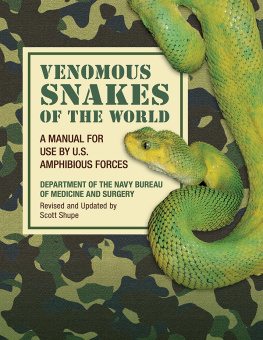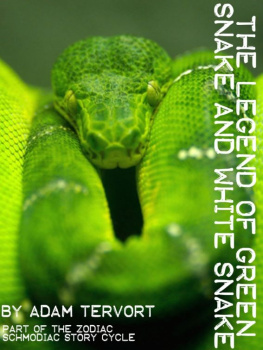


Snake men: John (left) and his father, George, shelter from the wind and rain while snaking at Dismal Swamp, western Victoria, in 1957. When the weather cleared they bagged 80 snakes.
(Courtesy of Eric Worrell)
Every effort has been made to trace the holders of copyright material. If you have any information concerning copyright material in this book, please contact the publishers at the address below.
First published in 2018
Copyright John Cann 2018
All rights reserved. No part of this book may be reproduced or transmitted in any form or by any means, electronic or mechanical, including photocopying, recording or by any information storage and retrieval system, without prior permission in writing from the publisher. The Australian Copyright Act 1968 (the Act) allows a maximum of one chapter or 10 per cent of this book, whichever is the greater, to be photocopied by any educational institution for its educational purposes provided that the educational institution (or body that administers it) has given a remuneration notice to the Copyright Agency (Australia) under the Act.
Allen & Unwin
83 Alexander Street
Crows Nest NSW 2065
Australia
Phone: (61 2) 8425 0100
Email:
Web: www.allenandunwin.com
Cataloguing-in-Publication details are available from the National Library of Australia
www.trove.nla.gov.au
ISBN 978 1 76063 051 5
eISBN 978 1 76063 532 9
Index by Puddingburn
Set by Bookhouse, Sydney
Cover design: Blue Cork
Front cover photographs: John as a teenager (top) and a rural snake show
To my great-great-grandkids,
the ones Ill miss out on,
so youll know where youre from
CONTENTS


George Cann
To the big crowd gathered at the La Perouse loop to watch the snake show in April 2010, it might have seemed like any other Sunday. But whether they knew it or not, they were all about to witness a little bit of history.
This would be the last snake show at the La Pa Loop presented by a member of the Cann clan, the last in an almost unbroken run of nearly 100 years. In that time, nothing short of wars and epidemics, poverty and the Great Depression had kept the La Perouse snake pit closed. To all intents and purposes, through all those years, if there was crowd, there would be a snake man (or woman) with the surname Cann ready to put on a show.
Because that day I may have been the last Cann to perform at the La Perouse snake pit, but I certainly wasnt the first. My father, George, already an accomplished snake man in his early teens, started the family tradition when he came back from World War I. My mother, Essieonce billed as Cleopatra, Queen of the Snakeskept it going, albeit reluctantly, when he was on the road doing country shows. My brother George and I then took over after Pop passed away.
And while back in the day there might have been more vaudeville and less natural history in the snake shows, their format rarely changed. Wed bring out the lizards, water dragons and goannas for the kids to see and stroke, and some lucky member of the audience would soon find a python draped around his or her neck. Then wed get to the serious stuff: the venomous snakes that could kill you with a bitefatal consequences that had been proved in the past on that very spot.
Yet while the snake show might have remained pretty much a constant down at La Perouse, times did change. Ive collected written reportsgoing back to the nineteenth centuryof the early days of snake handling in Australia.
Some snake handlers think theyre too smart for snakestheyre the ones who usually find out the hard way that if a snake wants you, hell get you. In the old days, the snakeys, as they were known, would take a bite from a venomous snake to prove how effective their antidote potions were. Sometimes the snakes had been milked and defanged (although that was no guarantee of safety), sometimes the snakeys had built up a level of resistance by taking many small bites. Maybe, just maybe, some of the antidotes actually had some effectbut probably not. The term snake-oil salesman surely has its roots in these travelling showmen with their dubious wares.
I have video footage of the last public show I did at the Loop. Id taken down my liveliest tiger snake, one that I would only show now and then because he scared me. He was too good for me, and I knew hed get me one of these daysif I gave him the chance.
Ill tell you what this tiger snakes going to do, I told the crowd of family, friends, casual onlookers and visiting dignitaries. Hell wriggle, like this, hell come halfway up, and then hell bite me on the wrist if he can.
And thats exactly what happened. I gripped him by the tail and lifted him. He wriggled, he came up, and he went straight for my wrist with his mouth open, but I rolled him over, and he was back in his bag before he knew it. His intent could not have been clearer. I wouldnt give him another go.
From the first red-bellied black snake I caught as a kid (earning a clip round the ear from Mum) to that show in 2010, snakes had been a huge part of my lifebut they werent my whole life. Along the way I also competed at the Olympics and played for New South Wales in the same team as some deadset legends of rugby league. Ive spent six months collecting animals in the jungles of New Guinea and become a recognised authority on Australian reptilesand especially turtles. Ive been a champion boxer, a published author and even appeared in a film with Raquel Welch (well, my chest did at least).
If all that sounds so improbable for the one man that you think Im spinning you a yarn, then read on and judge for yourself. I hope you enjoy this trip through a rich and varied life. Maybe once you start to read, itll be you who says he got me!
Some people call me the snake man of La Perouse but thats not quite right. That title belongs to my father, George Cann. Pop entertained and informed generations of visitors to the La Pa Loop, as it was known locally, and he combined the skills of a born showman with the expertise of a scientist. No one knew snakes better than my dad.
Pop was born in 1897, and his family goes back to the old country via New Zealand. Theres a hint of scandal along the way too. His paternal grandmother, Ellen Newman, and her brother Daniel came out from Kilkenny, Ireland, as assisted migrants in 1861. Ellen married James Duruz, from Switzerland, a year later and they had eight children, the last of whom was also James, born in 1876.
Ellens son James and my grandmotherconfusingly also named Ellen (Cann)were hooked up in what was more or less a marriage of convenience in 1897, just a couple of days before my father, Pop, was born on 16 April. Apparently they wed for no better reason than so the kid wouldnt be illegitimate. There was still quite a stigma attached to illegitimacy in those days. Queen Victoria was still on the throne, so Victorian values were as strong as theyd ever be. Soon after, James went his own way and Ellen Cann kept her family name and passed it on to her son, my father, George. Ellen ended up going to New Zealand, where her other family was (and many still are), and Pop was reared by his maternal grandfather, George Cann. Pop saw his real father when he was about twelve years old. He was walking with his uncle Frank, who was about ten years older than him, and a man rode past on a horse.
Next page















